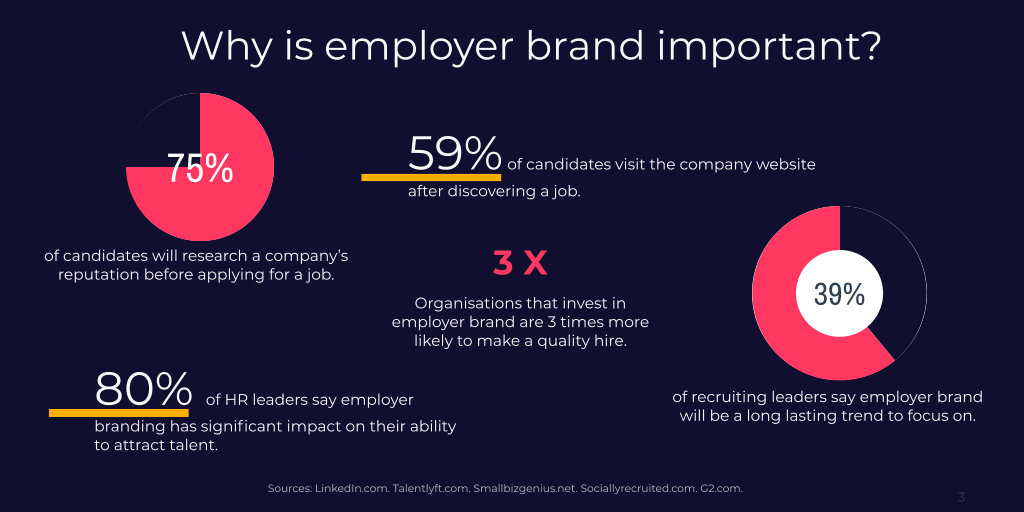
Employer brand. The forgotten tool in a business owner's playbook, pushed aside by traditional corporate marketing focused on lead generation and bottom-line figures.
Your employees are your most valuable asset, so investing in your employer brand should be just as important as investing in your corporate one. But to track the value and success of your branding, you need to know what metrics matter.
What is employer brand?
Employer brand is your business reputation and public image as an employer. As a job seeker, a strong employer brand is very influential when choosing a company and making a career move.
For employers, investing in their brand supports talent acquisition & retention through marketing tactics and employee engagement. This can be done through careers websites, marketing campaigns and advertising.
Branding is notoriously hard to measure and put KPIs against; however, certain results can indicate how your brand is being perceived. This data can show you where improvements can be made to ensure your marketing is attracting suitable candidates for your business.
Several elements factor into your employer’s brand, from talent attraction to employee satisfaction and retention. Like corporate marketing, your employer brand should consider future and existing employees to ultimately affect your bottom line.
Why is an employer brand strategy important?
By taking control of your employer brand, you control how job seeker perceives your business. You can target your ideal candidates through tailored marketing strategies with a clear goal and brand values.
A great employer brand strategy means attracting better candidates, keeping happy staff, and reducing cost per hire. However, building an aspiring employer brand takes time and commitment.

Your employer brand is an investment worth doing. Whilst many business owners don’t see the value, employer brand does affect your bottom line, making it easier to attract talent and reducing your cost per hire.
To ensure you’re not wasting your time, measuring the success of your efforts is essential. In the same way, you measure ROI for your corporate marketing, consider the project costs, time saved for hiring and costs saved per hire. This will give you a good idea of your strategy's effectiveness.
The Candidate Lifecycle
The candidate lifecycle, as shown below, is a repetitive model that helps businesses build effective strategies by focusing on the three main stages of an employee’s journey. Whilst all audiences will be different and should be segmented the same way customers are, this model identifies the crucial touchpoints for measuring success.
The candidate or recruitment lifecycle identifies the stages of a candidate's journey from the first interaction with a brand through to the employee experience. This model breaks down the talent acquisition process into three repetitive stages.
Attraction
Attraction is at the top of the marketing funnel and is directly related to brand awareness. At this stage, you should be focusing on traffic and applications. Are you getting more traffic to your site and job pages? If so, where is this traffic coming from? Have your applications increased, and are the candidates of high quality?
At this stage, you should be looking at increasing candidate applications, with KPIs being applications, candidate traffic and quality applications.
Engagement
Once you have candidates on your site, how are you nurturing the candidate experience?
Building great engagement is about considering both your passive and active audience and offering multiple touchpoints for conversion. Track how your current and future employees interact with you online. Beyond the website, how are you engaging through social media? Are you sharing company updates, employee milestones and achievements?
Retention
The ultimate indication of employee experience is your ability to keep staff.
The ultimate test of a quality employer brand and a happy workforce is your staff's happiness and your employees' turnover. Not only does this work towards your recruitment goals, but also further improves brand reputation through positive reviews, referrals and future team hiring.

How to measure your employer brand
Measuring the effectiveness of your employer brand can be subjective as it's not quite as clear-cut as commercial marketing and lead generation, but that doesn’t mean there's no data to be analysed. Use metrics that align with your business goals – identify your baseline figure to indicate how things are changing, your company may naturally have a high turnover rate, so it’s essential to know your start point.
You can calculate your marketing ROI with the simple sum below:
ROI = [(Financial value – project costs)/project costs] x 100
Top 10 metrics to use when measuring employer brand
An employer brand metric is any KPI related to your business goals concerning recruitment. For example, say your company has a growth goal to increase headcount by 30% in a year, a KPI would be quality applications and the number of offers accepted. KPIs can be made up of multiple metrics and are directly related to your business goals and the different stages of the candidate lifecycle.
Most employer brand metrics can be found on Google Analytics and your applicant tracking system. However, there are some elements that require additional tracking, such as associated costs and source of hire.
Much of the work you will do in branding will be to make your brand appeal to your perceived audience. To ensure that the work you’re doing is paying off, you should measure changes in your audience over time. Is the age or gender shifting to your target customer? Has a difference in the language and style of copy encouraged more applications? Has updating your look encouraged a growth in the demographic you want to appeal to?
Below we’ve listed the top 10 metrics we would recommend for businesses looking to analyse the performance and effectiveness of their employer brands.
1. Direct traffic
This shows people are searching for your brand directly and displays brand awareness. These users will use brand search terms to find your website and have already heard of your brand through other mediums.
2. Number of applications
A high number of applications is a good sign. In particular, the number of direct applications through your website or careers page shows the quality of your site and the ability to push candidates toward conversion.
3. Number of quality applications
The total number of applications only tells you so much. If you’re not attracting the ideal candidates, you’re doing something wrong. Break it down to see how many candidates got through to the interview stage, how many were given an offer and where these candidates came from. It may show that most of your successful candidates are coming from LinkedIn or referrals, in which case you’ll know that is where your efforts should go.
4. Offer acceptance rate
At the point of acceptance, the candidate will be well-engaged with your brand and have a clear idea of your values and culture. Whilst there are many other factors at play here, like salary and office location, the acceptance rate will give you a good indication of how your employer brand came across online and during the interview.
5. Cost per hire
This will help show how your employer brand efforts affect the company's bottom line. In a very broad sense, the cheaper the hire, the more your employer brand is working. This is because you’re not having to spend more on hiring fees, replacements and advertising. After all, your branding is doing the work for you.
7. Time to hire
Simply put, candidates will quickly accept a job offer if your business looks like a great workplace. Calculate your average time to hire and use this as a baseline. Long hiring times cost money, so it's in the business's best interest to make a quick, quality hire.
8. Employee engagement
Take a look at your social media channels, the engagement of your team across Instagram, LinkedIn and Twitter will show their support of the brand and indicate happiness in the workplace as well as loyalty to the employer.
9. Retention rate/staff turnover
This one may be obvious, but it should not be ignored. A high turnover may suggest your employer brand doesn’t match the real deal. Understanding where your business has high turnover will help you make the necessary changes and perhaps realign your employer brand strategy.
10. Referral rate
Are your past or current employees recommending you as a good employer? This can be seen through job referrals and reviews on Glassdoor or LinkedIn. The referral rate refers to the number of hires that come directly from referrals resulting in a job match.
Other indications of strong employer branding
Aside from the metrics, there are other signs you're doing an excellent job regarding employer brand. These may not be as easy to measure but are equally important.
Employer brand awards are easier to apply for and a huge achievement to win. Awards such as Fortune 100, Sunday Times 100 and Glassdoor Best Places to Work help to boost a brand's reputation internationally, making them more appealing to potential candidates. Employees provide feedback and score their employees on several factors. The results show employee satisfaction & happiness in their roles.
When candidates are researching potential employers, one of the first places they go is Glassdoor. A quality profile and positive Company reviews is an excellent sign of a good employer.
A sign of a good strategy is a business's ability to attract quality talent. You can use Google Analytics to check whether your traffic reflects your target demographic. With this information, you can alter your content, messaging and campaigns to target your ideal customer.
Let's take it back to basics. When was the last time you did an employee survey? Gaining direct feedback from your staff gives them a chance to provide anonymous thoughts and feelings to help you improve the overall experience.
In addition, tools such as The happiness index helps employers evaluate the engagement levels of employees to determine their satisfaction and general enjoyment of the role and business. This kind of data-driven insight allows you to build a better culture for your team.
Measuring employer brand
A strong employer brand strategy is more critical now than ever, with candidates looking for meaningful careers at a business that inspires them. Therefore, investing in your employer brand should be a high priority and, like commercial marketing, should be measured, tracked and optimised over time to help you achieve your business growth goals.
At Venn, we specialise in career website design and recruitment marketing strategy for agency and employer brands and have a rich history in the careers sector. Discover more about the Role of Careers Websites for Employer Brand and speak to an expert today to learn more about our services.



